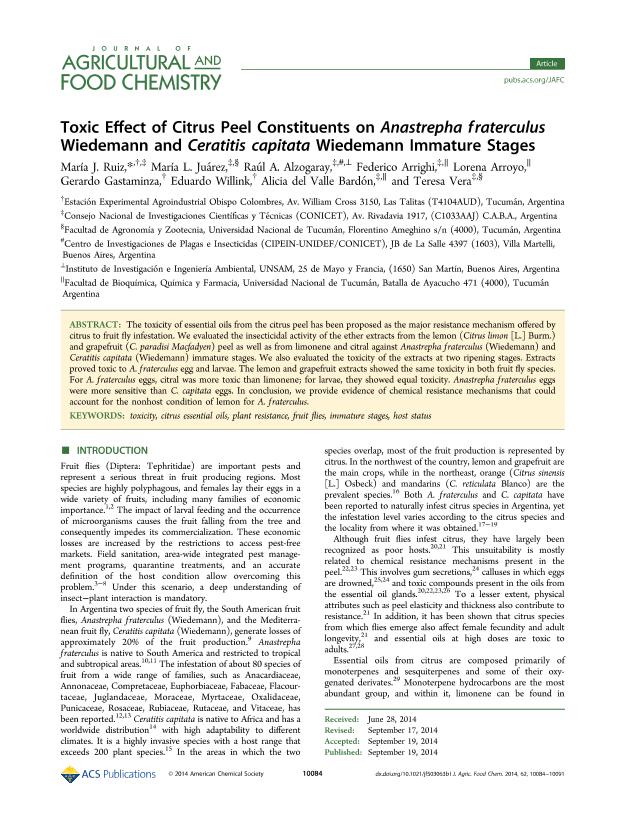Artículo
Toxic effect of citrus peel constituents on Anastrepha fraterculus Wiedemann and Ceratitis capitata Wiedemannimmature stages
Ruiz, María J.; Juárez, María Laura ; Alzogaray, Raul Adolfo
; Alzogaray, Raul Adolfo ; Arrighi, Carlos Federico
; Arrighi, Carlos Federico ; Arroyo, Lorena; Gastaminza, Gerardo; Willink, Eduardo; del Valle Bardón, Alicia; Vera, Maria Teresa
; Arroyo, Lorena; Gastaminza, Gerardo; Willink, Eduardo; del Valle Bardón, Alicia; Vera, Maria Teresa
 ; Alzogaray, Raul Adolfo
; Alzogaray, Raul Adolfo ; Arrighi, Carlos Federico
; Arrighi, Carlos Federico ; Arroyo, Lorena; Gastaminza, Gerardo; Willink, Eduardo; del Valle Bardón, Alicia; Vera, Maria Teresa
; Arroyo, Lorena; Gastaminza, Gerardo; Willink, Eduardo; del Valle Bardón, Alicia; Vera, Maria Teresa
Fecha de publicación:
2014
Editorial:
American Chemical Society
Revista:
Journal Of Agricultural And Food Chemistry
ISSN:
0021-8561
e-ISSN:
1520-5118
Idioma:
Inglés
Tipo de recurso:
Artículo publicado
Resumen
The toxicity of essential oils from the citrus peel has been proposed as the major resistance mechanism offered by citrus to fruit fly infestation. We evaluated the insecticidal activity of the ether extracts from the lemon (Citrus limon [L.] Burm.) and grapefruit (C. paradisi Macfadyen) peel as well as from limonene and citral against Anastrepha f raterculus (Wiedemann) and Ceratitis capitata (Wiedemann) immature stages. We also evaluated the toxicity of the extracts at two ripening stages. Extracts proved toxic to A. f raterculus egg and larvae. The lemon and grapefruit extracts showed the same toxicity in both fruit fly species. For A. f raterculus eggs, citral was more toxic than limonene; for larvae, they showed equal toxicity. Anastrepha f raterculus eggs were more sensitive than C. capitata eggs. In conclusion, we provide evidence of chemical resistance mechanisms that could account for the nonhost condition of lemon for A. f raterculus.
Archivos asociados
Licencia
Identificadores
Colecciones
Articulos(CCT - NOA SUR)
Articulos de CTRO.CIENTIFICO TECNOL.CONICET - NOA SUR
Articulos de CTRO.CIENTIFICO TECNOL.CONICET - NOA SUR
Articulos(UNIDEF)
Articulos de UNIDAD DE INVESTIGACION Y DESARROLLO ESTRATEGICOS PARA LA DEFENSA
Articulos de UNIDAD DE INVESTIGACION Y DESARROLLO ESTRATEGICOS PARA LA DEFENSA
Citación
Ruiz, María J.; Juárez, María Laura; Alzogaray, Raul Adolfo; Arrighi, Carlos Federico; Arroyo, Lorena; et al.; Toxic effect of citrus peel constituents on Anastrepha fraterculus Wiedemann and Ceratitis capitata Wiedemannimmature stages; American Chemical Society; Journal Of Agricultural And Food Chemistry; 62; 41; -1-2014; 10084–10091
Compartir
Altmétricas



